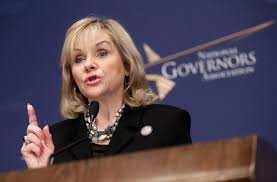
Oklahoma Gov. Mary Fallin is taking some of the credit for the fall of unemployment rates in every Oklahoma County in September, saying it’s a result of the pro-business policies enacted during her administration.
She said it shows the policies are working.
“Oklahoma’s overall economy is healthy,” the governor said at a Seminole Chamber of Commerce forum. “The challenge ahead is to keep our economy strong and make sure our state is prepared for an economic downturn.”
Unemployment rates were lower in September than a year ago in all 77 counties, according to a report released this week by the Oklahoma Employment Security Commission. The statewide jobless rate for September was 3.5 percent, down from 3.7 percent in August. Oklahoma’s unemployment rate was 6.2 percent when Fallin took office in January 2011.
The jobless rate fell 0.9 percentage points in the Oklahoma City metro area and 1.3 percent in the Tulsa metro area since September 2017, hitting rates of 2.8 percent in Oklahoma City and 3 percent in Tulsa. A month earlier, unemployment was at 3.2 percent in Oklahoma City and 3.5 percent in Tulsa.
Oklahoma’s unemployment rate is dropping, even though the state’s population is increasing.
“Oklahoma’s most recent population estimate of 3.93 million illustrates the consistent, positive growth trend the state has seen in recent years,” said Fallin. “It appears Oklahoma’s population could be 4 million during the upcoming 2020 census.
“Oklahoma’s overall economy is healthy,” the governor said in comments at a Seminole Chamber of Commerce forum. “The challenge ahead is to keep our economy strong and make sure our state is prepared for an economic downturn.”
Oklahoma offers an incredibly low cost of doing business, Fallin said. For the second year in a row, the Anderson Economic Group’s 2018 State Business Tax Burden Rankings ranks Oklahoma with the lowest tax burden in the country.
“Keep in mind that Oklahoma has one of the lowest costs of living in the U.S., such as our state having the second-lowest electric power costs in the country, and at the same time offers a great quality of life,” she said.
During Fallin’s administration, Oklahoma has secured 508 new and expanding business announcements. These are just projects led by the state Department of Commerce.
“We’ve seen 508 new and expanding business announcements throughout the state,” she said. “These businesses represent more than 60,000 new jobs, with a total payroll of $3.2 billion and investments of $13.6 billion. The average annual salary is $54,226.”
These are just new or expanding jobs; this number does not include retention of businesses because those mostly don’t result in new jobs.
The federal Bureau of Labor Statistics reports Oklahoma’s economy has grown 125,700 jobs from January 2011 through July 2018.
“When you look at job numbers tallied by cities and other local entities, the estimate could be closer to 200,000 new jobs,” Fallin said.
“We’re also seeing results of efforts to diversify the economy. Oil and gas will be a dominant part of our economy in the years to come, but we’re attracting other industries.”
During the 2018 fiscal year, the largest percentage of new and expanding jobs came from a group that included manufacturers of medical equipment, heat and air equipment, custom fire trucks, foam products, sanitary paper products and metal fabrication, the governor said. It represented 16 percent of the new jobs.
The transportation and distribution category, which includes the two large Amazon distribution centers in Oklahoma City and Tulsa, came in second at 12 percent.
Aerospace and defense industries tied with energy for third at 11 percent.
Fallin said pro-business policies that she supported and signed into law helped spur Oklahoma’s economy and lower the state’s unemployment rate:
- Transitioning Oklahoma to an administrative workers’ compensation system committed to taking care of injured workers yet reducing the state’s average workers’ comp loss costs rates nearly 64 percent lower than they were in January 2011.
- Making Oklahoma more business friendly by enacting tort reform measures: Oklahoma has moved from 42nd to 31st in reducing frivolous lawsuits.
- Cutting Oklahoma’s unfunded pension liability of $16 billion nearly in half to about $8.4 billion.
New revenue sources approved in the 2017 and 2018 legislative sessions will establish a much more stable financial position for the state, and allowed Oklahoma this year to give a raise to public school teachers, which Fallin had pushed for the last three years.
Teachers will see an average pay raise of $6,100, or a 16 percent pay increase – the highest pay increase in state history. Oklahoma’s teacher pay went from 49th to 29th in the nation, and to No. 12 when the cost of living is factored. In Oklahoma’s seven-state region, teacher pay went from last to No. 2.
This year, the Legislature passed, and Fallin signed the largest K-12 education appropriation bill in state history. The current 2019 fiscal year appropriations for education is $2.9 billion – compared with $2.4 billion last year, an increase of $480 million, or 19.7 percent.






